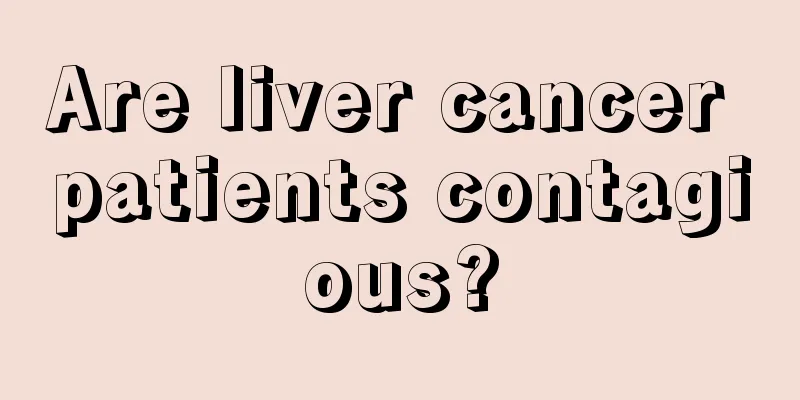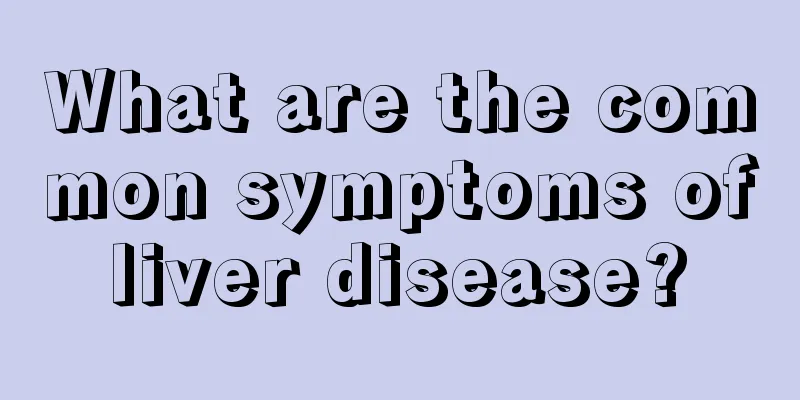What are the symptoms of endometrial cancer? What are the contraindications of endometrial cancer?

|
Endometrial cancer, also known as uterine body cancer, is a disease mainly caused by malignant tumor lesions in the endometrial epithelial tissue. It has a high incidence rate, second only to cervical cancer, and ranks second among the three major malignant tumors of the female reproductive tract. The incidence rate has been on the rise in recent years, which is greatly related to the bad living habits of female patients. Women should be vigilant, develop good living habits, remove inducements, and take preventive measures. 1. Vaginal bleeding It is the most important clinical symptom of endometrial cancer. It manifests as: (1) Postmenopausal vaginal bleeding: 70%-75% of endometrial cancer patients are postmenopausal women, and more than 90% have vaginal bleeding. It manifests as continuous or intermittent vaginal bleeding, with varying amounts. Generally, the amount of bleeding is not much, and heavy bleeding is rare. There are also cases where heavy bleeding suddenly occurs several years after menopause. (2) Perimenopausal vaginal bleeding: It manifests as irregular menstrual cycle, prolonged menstruation or increased menstrual flow, or irregular vaginal bleeding. About 20% of endometrial cancer patients are perimenopausal women. Another 5% are women under 40 years old. 2. Vaginal discharge About 1/3 of patients have increased vaginal discharge, which manifests as serous or bloody secretions. When combined with intrauterine infection or pyometra, the discharge may be purulent or bloody, and sometimes have a foul odor. 3. Pain Usually it does not cause pain. A small number of patients have lower abdominal pain, which is persistent pain or distending pain, which may be related to the large lesion protruding into the uterine cavity and stimulating uterine cavity contracture. The pain is more obvious when there is fluid accumulation or pus accumulation in the uterine cavity or when advanced cancer infiltrates surrounding tissues or compresses nerves. It manifests as persistent pain in the lower abdomen, lumbar sacral region and legs. 4. Systemic symptoms Patients with endometrial cancer generally have obesity, diabetes, and hypertension. In the early stages of gynecological examinations, pelvic examinations are usually normal, but in the late stages, there may be signs of uterine enlargement, adnexal masses, anemia, weight loss, cachexia, and distant metastasis. 1. Endocrine disorders Endometrial cancer mainly occurs in perimenopausal and postmenopausal women. Due to the great changes in hormones, endocrine system and other factors in women's bodies during this stage, endometrial cancer is easily induced. 2. Estrogen-dependent Under the long-term action of estrogen without progesterone antagonism, endometrial hyperplasia and even cancer may occur. Clinically, it is common in anovulatory diseases, estrogen-secreting tumors, postmenopausal women who take estrogen for a long time, and women who take tamoxifen for a long time. This type accounts for the majority of endometrial cancers, all of which are endometrial adenocarcinomas. The tumors are well differentiated, the positive rate of estrogen and progesterone receptors is high, and the prognosis is good. Patients are relatively young and often accompanied by obesity, hypertension, diabetes, infertility or sterility, and delayed menopause. About 20% of endometrial cancer patients have a family history. 3. Non-estrogen dependent There is no clear relationship between the onset and estrogen. The pathological morphology of this type of endometrial cancer is a rare type, such as endometrial serous papillary carcinoma, clear cell carcinoma, adenosquamous carcinoma, mucinous adenocarcinoma, etc. It is more common in elderly thin women. The atrophic endometrium may be around the cancer. The tumor is highly malignant and poorly differentiated. Estrogen and progesterone receptors are mostly negative, and the prognosis is poor. 1. Female patients should improve their awareness of disease prevention, develop the habit of regular gynecological examinations, and detect and treat endometrial cancer early. 2. Develop good living habits, do not smoke, do not drink, eat healthily and reasonably, especially postmenopausal women should pay more attention to their living habits. 3. Be alert to vaginal bleeding: when irregular vaginal bleeding occurs, be sure to go to the hospital for examination in time to find out the cause and avoid bleeding caused by uterine disease. 3. Strictly control the indications of estrogen. 1. Radiation therapy It is a commonly used treatment for endometrial cancer. There is still controversy about the effect and application of radiotherapy. However, it is generally believed that for stage I grade I, without myometrial invasion, simple surgery is sufficient. For stage I poorly differentiated cancer (grade II and III), myometrial invasion >1/2, lymph node metastasis and stage II endometrial cancer, preoperative intracavitary radium therapy is currently used followed by total hysterectomy and bilateral salpingo-oophorectomy and postoperative auxiliary external irradiation. 2. Surgical treatment At present, there is a relatively consistent opinion that most stage I and II endometrial cancers can be cured by surgery, which is a good treatment for endometrial cancer. For stage Ia G1 cancer, it can be cured by total hysterectomy plus bilateral adnexectomy. For stage I poorly differentiated cancer (G2 and G3), total hysterectomy plus bilateral adnexectomy combined with radiotherapy is more effective than surgery alone. When the diameter of the uterine cavity is >10cm, this combination of therapy is also appropriate. 3. Hormones and chemotherapy Progesterone can transform abnormally proliferative endometrium into secretory or atrophic endometrium, which can lead to atrophy and reversal of endometrial adenomatous hyperplasia or adenoma. About 1/3 of patients with advanced or recurrent endometrial cancer respond to progesterone preparations, especially those with lung metastasis, with about 35% of patients showing significant responses. However, it is not effective for recurrent or persistent lesions in the pelvic cavity. This is also a commonly used treatment for endometrial cancer. 1. It is not advisable to eat too early. Generally, you should start drinking a small amount of water after the anus is exhausted. If there is no discomfort, you can eat liquid food, such as rice soup, vegetable soup, etc., and then gradually transition to soft food and ordinary food. 2. The diet after endometrial cancer surgery should not be too refined. In daily life, most people often eat a high-protein, high-calorie diet, ignoring the intake of vitamins. The body needs a variety of nutrients to repair, especially crude fiber foods. For patients who are bedridden after surgery, eating crude fiber foods can promote gastrointestinal activity and keep bowel movements smooth. 1. Avoid spicy foods and drinks such as peppers, peppercorns, raw onions, raw garlic, and white wine. Eat nutritious dried fruits such as peanuts, sesame seeds, melon seeds, etc. Eat more lean meat, chicken, eggs, quail eggs, crucian carp, turtle, white fish, cabbage, asparagus, celery, spinach, cucumber, winter melon, mushrooms, tofu, kelp, seaweed, fruits, etc. 2. Eat a light diet and avoid mutton, shrimp, crab, eel, salted fish, black fish and other hairy foods. Eat regularly and quantitatively, do not overeat, stick to a low-fat diet, eat more lean meat, eggs, green vegetables, fruits, etc. Eat more whole grains such as corn, beans, etc. 3. Avoid spicy food, alcoholic food, frozen food, etc. Avoid longan, red dates, donkey-hide gelatin, royal jelly and other foods that are hot, coagulant and contain hormones. |
>>: What are the early symptoms of bladder cancer? What is the cure rate of bladder cancer?
Recommend
Is it okay to wash your face with table salt?
Due to the proliferation of various cosmetics on ...
How high is the creatinine level to be considered uremia?
How high is the creatinine level to be considered...
I always feel congested after eating
Eating provides nutrition to our bodies. We shoul...
Why does my lower back hurt after scraping?
Gua Sha has many benefits for the body, such as p...
You are actually really hurting your ovaries by doing this
What bad habits in life are invisibly harming you...
What are the symptoms of lung cancer bone metastasis? The three most obvious symptoms of lung cancer bone metastasis
The symptoms of lung cancer may not be very obvio...
Is a slow fetal heart rate a boy or a girl?
When pregnant women are at home, they often use s...
What is the reason for high crystallinity in urine routine examination
There are many reasons for high crystallization i...
Can liver cancer be cured?
How long can you live with the pain of late-stage...
What are the complications of liver surgery?
For people, the most serious diseases occur in th...
The top five devilish moments in a person's life when they are most likely to get sick
In this period of continuous severe cooling weath...
The emergency treatment method after being scalded by boiling water will definitely be useful!
1. Rinse the burned area with running cold water ...
What are the dangers of ovarian cancer in middle age
Ovarian cancer is a gynecological disease that se...
What are the symptoms of mushroom poisoning
The phenomenon of mushroom poisoning is not uncom...
Why does my tongue go numb after eating pineapple?
Pineapple is a kind of tropical fruit. Pineapple ...









